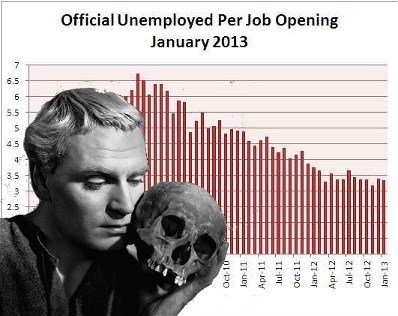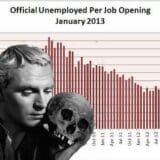

President Obama took yet another stab Tuesday at boosting the economy, offering congressional Republicans a cut in the corporate tax rate in return for a $50 billion investment in sagging U.S. infrastructure. That the GOP immediately rejected the deal should come as no surprise. But Republicans should at least be made to stipulate where they think investment in the United States is going to come from.
Conservatives’ stock answer is that if we just lift regulations and cut taxes on business, if we only get rid of unions and the minimum wage, then corporate investment will flow like a mighty stream. There are all kinds of good reasons to dispute this, but a study by three economists provides proof positive that it is sheer hooey.
In late April, John Asker and Alexander Ljungqvist of NYU’s Stern School of Business and the National Bureau of Economic Research and Joan Farre-Mensa of Harvard Business School published a study looking at one of the U.S.
» Read more about: America’s Investment Gap is Strangling Its Economy »


Endless debates over austerity vs. stimulus policies agitate governments. Which is “the correct” one to escape global capitalism’s ongoing crisis? The debates proceed as if official policies were key to ending crises. But the politicians’ fights over policies are mostly distractions from the main events: how crises usually end themselves and their immense social costs.
In the U.S., Republicans promote policies that prioritize national debts as “the” economic problem. Enlarged debts, they assert, prevent businesses from making investments that “create jobs.” Republicans therefore demand austerity policies – chiefly cutting government spending – to reduce national debts and thereby exit crises. Democrats – at least those who still differ from Republicans – promote policies that prioritize reducing unemployment. They want increased government stimulus spending even if national debts rise. That spending, they argue, will boost demands for goods and services, thereby creating jobs and pulling the economy out of crisis.


(They drive our trains and buses, teach our children, repair our roads and protect our safety. Public employees perform these and countless other jobs, although they remain mostly off the radar of the public they serve. With our new “Pro Publica” series, Frying Pan News presents the lives of these men and women front and center.)
After 10 years of marriage, Aisha Blanchard-Young’s husband is still shocked by the amount of time Aisha spends in her kindergarten classroom teaching. He jokes that if someone really wants to find out what it is like to be a teacher, they should talk to a teacher’s spouse. As a quality control technician for a stadium electronics company, he never has to take his work home. Aisha isn’t as lucky.
During the school year Aisha gets up at five in the morning to ready herself and the couple’s two boys (one 5 and one 2) for the day.
» Read more about: Aisha Blanchard-Young: A Passion for Teaching »


In the Food Network’s popular show, Restaurant Impossible, star Robert Irvine visits a failing restaurant that is poorly managed, has depressing décor, and which serves inedible food. He and his staff completely transform the business, and by show’s end there are hugs and smiles all around. Many of the restaurants Irvine visits are completely unsanitary. In a recent episode, Irvine told the owners that their place had “over 500 health code violations.” He said the kitchen was so disgusting that he would not even try the food, and told diners that they were eating at their own risk.
But neither Irvine nor the Food Network reported the establishment to the local health department. Nor did they ask how such a “disgusting” kitchen could have gone uninspected by city officials, or raise alarms as to the likelihood there were many other restaurants in the city also endangering their customers’ health.
» Read more about: Why ‘Restaurant Impossible’ Blows the Wrong Whistle »


you want dogs? I walked all four shepherds
in the park, by day and dark
and nobody dared come near; bark?
all they had to do was walk,
the four big shepherds in the park
love? you want love? I hardly miss her;
but her dogs I walked
by day and dark, yes,
I miss the dogs, the four
big shepherds in the park.
——————————————————–——————————————————–
Source: Intensifications, published by Red Hen Press (2010).
Originally from Brooklyn, N.Y., Austin Straus has been drawing and painting since childhood, but began writing seriously in his mid-thirties. His poems and illustrations have appeared in such literary magazines and anthologies as Caliban, Grand Passion, Jacaranda Review, Red Dance Floor and The Maverick Poets. Known as the host of KPFK’s The Poetry Connexion,


The National Labor Relations Board (NLRB) is now fully staffed and able to continue to function to protect workers’ rights after the U.S. Senate today confirmed five members. The votes end a months-long blockade on President Obama’s nominees by Senate Republicans who threatened to shut the board down Aug. 27.
AFL-CIO President Richard Trumka says the confirmations are:
Good news for all workers seeking to exercise the rights they are guaranteed by law. Those essential rights include the ability to bargain together for fair wages and living standards and a workplace safe from abuse, harassment and intimidation.
The five members are current NLRB Chairman Mark Pearce; Nancy Schiffer, a former AFL-CIO associate general counsel; and NLRB attorney Kent Hirozawa, currently the chief counsel to Pearce; and attorneys Philip Miscimarra and Harry Johnson, who represent management in labor-management relations.
Earlier this month, as Senate Majority Leader Harry Reid (D-Nev.) was set to change Senate rules that would have eliminated filibusters against certain executive branch nominees,
» Read more about: Finally: National Labor Relations Board at Full Strength »


Last November unions won a resounding victory when voters defeated Proposition 32, a ballot measure that would have crippled labor’s political influence in California, partly by barring public-employee unions from using payroll-deducted funds for political purposes. The initiative, which enjoyed a huge lead in early opinion polls, was heavily funded by wealthy conservatives and far-right groups.
Union leaders were overjoyed by its defeat.
“You can’t buy California,” Dean Vogel, president of the California Teachers Association (CTA), told an election-night victory party in Sacramento. “We’re not for sale.”
The celebration hasn’t been long lived. In a little-noticed move in April, a conservative legal organization that has pushed to overturn the 1964 Voting Rights Act filed a lawsuit in federal court in Santa Ana that could accomplish in the courts what Prop. 32 couldn’t at the ballot box. The players behind the suit may not be household names but the millionaires and private foundations covering their legal fees represent a familiar klatch of extreme libertarians who,
» Read more about: Prop. 32 Ghost Looms Over Lawsuit Against Teachers Union »
Imagine a Mexican father telling his child that he’s leaving for America. He probably wouldn’t spend a lot of time explaining the complicated economic and political relationship between Mexico and the U.S., nor would he spend a lot of time explaining how difficult and dangerous the journey to el norte would be.
It would be a simple explanation, in all likelihood: “I have to go north to find work to earn money for my family.”
The children’s story Pancho Rabbit and the Coyote by Duncan Tonatiuh starts with a statement much like that. Like so many Mexican workers, Pancho Rabbit’s father decides go to north because of lack of work at home – “The rains did not come and the crops would not grow.”
Papá Rabbit, along with companions including Señor Ram and Señor Rooster, leave at the beginning of the story. The story is told from the point of view of Papá Rabbit’s family,


Last week President Obama gave a speech at Knox College in Illinois in which he announced plans to return his focus to the economy. The agenda he outlined centered on policies to rebuild the middle class leading to growth from the middle out as he put it.
The basic idea sounds good. There are few who would take issue with the focus of his policies: improving the nation’s infrastructure, better school to work transitions, high quality pre-school for everyone. These ideas all score very high in opinion polls and focus groups, although there might be serious differences on what they mean concretely.
But even if we can agree on the best way to rebuild our infrastructure, better our schools, and guarantee high quality pre-school education we will still face serious economic problems well into the future for the simple reason that the economy lacks demand. Generating demand has to be issue one,
» Read more about: A Demand Economy: What’s Needed for Growth »